Automatic High Beam
The Automatic High Beam uses an in-vehicle camera sensor to assess the brightness of streetlights, the lights of oncoming and preceding vehicles, etc., and automatically turns high beam on or off as necessary.
Activating the Automatic High Beam system
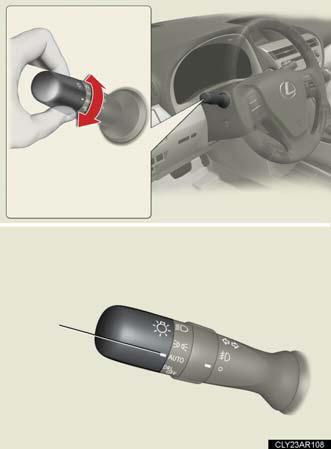
Turn the headlight switch to the
 position.
position.
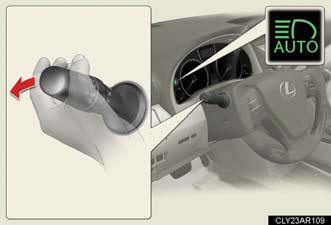
Push the lever away from you.
The Automatic High Beam indicator
will come on when the
headlights are turned on automatically
to indicate that the system
is active.
Turning the high beam on/off manually
- Switching to low beam
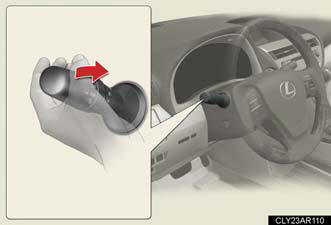
Pull the lever to original position.
- Switching to high beam
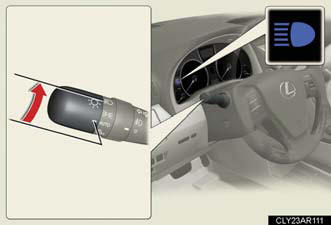
Turn the light switch to
position.
High beam automatic turning on or off conditions
When all of the following conditions are fulfilled, high beam will be automatically turned on (after approximately 1 second): Vehicle speed is above approximately 20 mph (32 km/h).
The area ahead of the vehicle is dark.
There are no oncoming or preceding vehicles with headlights or tail lights turned on.
If any of the following conditions are fulfilled, high beam will be
automatically
turned off:
Vehicle speed drops below approximately 20 mph (32 km/h).
The area ahead of the vehicle is not dark.
Oncoming or preceding vehicles have headlights or tail lights turned on.
The Automatic High Beam can be operated when
The “POWER” switch is ON mode.
Limitations of the Automatic High Beam
Do not rely on the Automatic High Beam. Always drive safely, taking care to observe your surroundings and turning high beam on or off manually if necessary.
Camera sensor detection information
High beam may not be automatically turned off in the following situations: • When oncoming vehicles suddenly appear from a curve.
• When the vehicle is cut in front of by another.
High beam may be turned off if an oncoming vehicle that is using fog lights
without
using the headlights is detected.
House lights, street lights, red traffic signals, and illuminated billboards
or signs
may cause the high beam to turn off.
The following factors may affect the amount of time taken to turn high beam
on
or off:
• The brightness of headlights, fog lights, and tail lights of oncoming and
preceding
vehicles.
• Road conditions (wetness, ice, snow etc.).
• The number of passengers and amount of baggage.
High beam may be turned on or off when unexpected by the driver.
In the situations below, the system may not be able to correctly detect the
surrounding
brightness levels, and may flash or expose nearby pedestrians to the
high beam. Therefore, you should consider turning the high beam on or off
manually rather than relying on the Automatic High Beam system.
• In bad weather (rain, snow, fog, sandstorms etc.).
• The windshield is obscured by fog, mist, ice, dirt etc.
• The windshield is cracked or damaged.
• The inside rear view mirror or camera sensor is deformed or dirty.
• Surrounding brightness levels are equal to those of headlights, tail lights or fog lights.
• Vehicles ahead have headlights that are either switched off, dirty, are
changing
color, or have are not aimed properly.
• When driving through an area of intermittently changing brightness and darkness.
• When frequently and repeatedly driving ascending/descending roads, or roads with rough, bumpy or uneven surfaces (such as stone-paved roads, gravel tracks etc.).
• When frequently and repeatedly taking curves or driving on a winding road.
• There is a highly reflective object ahead of the vehicle, such as a sign or a mirror.
• The vehicle's headlights are damaged or dirty.
• The vehicle is listing or tilting, due to a flat tire, a trailer being towed etc.
• The Automatic High Beam indicator is flashing.
• The high beam and low beam are repeatedly being switched between in an abnormal manner.
• The driver believes that the high beam may be causing problems or distress to other drivers or pedestrians nearby.
If the Automatic High Beam indicator flashes
It may indicate a malfunction in the system. Contact your Lexus dealer.
Temporary lowering sensor sensitivity
The sensitivity of the sensor can be temporarily lowered.
To lower the sensitivity, push and hold the “AUTO” button on the inside rear
view
mirror for 15 to 20 seconds, and release. The indicator light on the inside rear
view
mirror will flash to indicate that the sensitivity has been lowered.
When the “POWER” switch is turned off, the sensitivity will be returned to its
normal
level.
Customization that can be configured at your Lexus dealer
The Automatic High Beam can be turned off.
NOTICE:
Notes when using the Automatic High Beam system
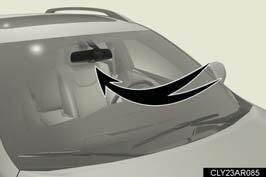
Observe the following to ensure that the Automatic High Beam functions correctly.
Do not touch the camera sensor.
Do not subject the inside rear view mirror or the camera sensor to a strong impact.
Do not disassemble the camera sensor.
Do not spill liquid onto the inside rear view mirror or the camera sensor.
Do not apply window tinting or stickers to the camera sensor or the area of
windshield
near the camera sensor.
Do not place items on the dashboard. There is a possibility that the camera
sensor
will mistake items reflected in the windshield for streetlights, the headlights
of
other vehicles, etc.
Do not install a parking tag or any other accessories near or around the
inside
rear view mirror and the camera sensor.
Do not overload the vehicle.
Do not modify the vehicle.
Do not replace windshield with non-genuine windshield.
Contact your Lexus dealer.
See also:
Using the Bluetooth® audio system
Audio unit
1. Display.
A message, name, number,
etc. is displayed.
Lower-case characters and
special characters cannot be
displayed.
2. Displays information that is
too long to be displayed ...
Any breakthroughs?
As the oldest offering in its segment, the GS 460 doesn’t exactly brim with
unexpected touches. But at $60,490 as tested, it offers a surprisingly good
value. Our tester included radar cruise cont ...
F Sport Performance Accessories
Lexus offers a selection of F Sport Performance Accessories for the IS
models, including performance-enhancing parts such as 19-inch forged alloy
wheels, brake upgrades, suspension systems, air in ...
